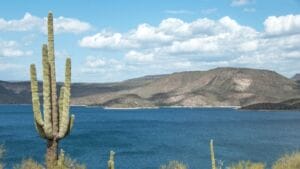Nearly a dozen Western mayors gathered Wednesday to discuss anything and everything “water” except the region’s drought contingency plan – what Phoenix Mayor Greg Stanton called “the 800-pound gorilla in the room.”
Stanton, speaking after a panel on the issue at the U.S. Conference of Mayors meeting here, said the federal contingency plan is under “delicate negotiation” and that it is better left untouched by the mayors – for now. The plan will determine how water from the Colorado River, and Lake Mead, is allotted.
“The drought contingency plan is at a very precarious point right now,” Stanton said after leading the second annual panel of mayors on water. “I didn’t want any of the conversation here, among the leading mayors, to mess up any balance that’s going on.”
That limitation didn’t stop the mayors from sharing ideas and bragging about their cities’ successes in cutting water use.
“The point of bringing this group together was making us challenge each other, be our better selves, go further than we thought we were going to go on water conservation policy,” Stanton said.
Arizona mayors at the meeting pointed to their success not just in reducing water consumption, but in doing so while their populations have increased.
“Phoenix has grown 30 percent over the last 20 years, but we use less water than we did 10 years ago – not per capita, we use overall, less water,” Stanton said.
Tucson Mayor Jonathan Rothschild talked about the success of his city’s efforts to conserve water, and he said Tucson’s water table is rising. He cited the city’s “beat the peak” initiative, which encouraged Tucson residents to refrain from watering their grass or plants in the hottest parts of the day, as one of its most impressive efforts.
“It’s really simple: no water, no nothing,” Rothschild said.
Tempe Mayor Mark Mitchell discussed the tiered rate structure his city uses to encourage residential water conservation. The tiered structure ensures that those who are consuming the least amount of water possible are rewarded with lower utility bills, and that those who are over-using water see an increase in their monthly expenses.
In order to calm residents who are concerned about increasing water bills, the city offers free water audits, inspecting a home’s water usage and pipe system for ways to decrease consumption if the homeowner asks.
All the mayors agreed that greater water conservation begins in individual cities.
Each mayor discussed their attempts and successes in reaching out to consumers with cheeky water campaigns and newsletters, knowing that education is key to minimizing overconsumption of water.
Mitchell, in particular, explained that Tempe recognized that many residents were overwatering their grass and plants. In response, the city is reaching out to new homeowners to inform them of the proper watering amounts.
Sarah Porter, director of Arizona State University’s Kyl Center for Water Policy, agreed with the mayors that next to research, education is crucial to water conservation success.
“You want children and residents and really everyone, to really understand where their water comes from,” said Porter, who moderated the session. “We need to educate people, to understand water.”
Despite the session’s focus on local solutions, Stanton said the mayors will keep a close eye on the federal government’s progress on the drought contingency plan.
“That was one of the reasons why we formed the Western mayors water group,” Stanton said. “To really send a message that I think too often, cities like Phoenix, one of the biggest cities in America, I don’t want to defer to somebody else to stand up for the people that I represent on water policy and water planning.”
Porter assured the mayors that she is optimistic about the drought contingency negotiations that are underway.
By Kendra Penningroth, Cronkite News



